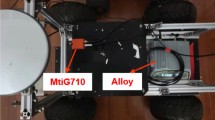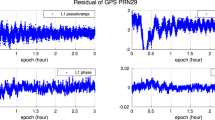Abstract
It is well-known that the integer ambiguities of network real time kinematics (RTK) in GPS can hardly be precisely resolved because of the small change of position dilution of precision (PDOP) within a few observation epochs. In response to this, an integer ambiguities resolution method aided by the high precision quantum ranging is proposed, in which the Householder transformation is employed to preserve the independence of different observations. Consequently, the reliability of the integer ambiguities’ floating solution is improved mathematical analysis and simulation experiment are conducted to validate the effectiveness of the proposed method.
Similar content being viewed by others
References
NovAtel Inc. Introducing NovAtel’s New AdVance RTK NovAtel Technical Report, 2000
Raquet J, Lachapelle G. RTK positioning with multiple reference stations. GPS World, 2001, 12: 48–53
Chang X W, Paige C C, Yin L. Code and carrier phase based short baseline GPS positioning: computational aspects. GPS Solution, 2005, 9: 72–83
Teunissen P J, Tiberius C C. The least-squares ambiguity decorrelation adjustment: its performance on short GPS baselines and short observation spans. J Geodesy, 1997, 71: 589–602
Chang X W, Yang X, Zhou T. MLAMBDA: A modified LAMBDA method for integer least-squares estimation. J Geodesy, 2006, 79: 552–565
Giovannetti V, Lloyd S, Maccone L. Quantum enhanced positioning and clock synchronization. Nature, 2001, 412: 417–419
Giovannetti V, Lloyd S, Maccone L. Quantum-enhanced measurements: beating the standard quantum limit. Science, 2004, 306: 1330–1334
Giovannetti V, Lloyd S, Maccone L. Positioning and clock synchronization through entanglement. Phys Rev A, 2001, 88: 183602-1–183602-4
Giovannetti V, Lloyd S, Maccone L. Quantum positioning system. In: Proceedings of the 8th Rochester Conference on Coherence and Quantum Optics. New York: Kluwer Academic/Plenum Publishers, 2003. 323–324
Thomas B B. Quantum positioning system. In: 36th Annual Precise Time and Time Interval (PTTI) Meeting, Naval Observatory. Washington DC, 2005. 423–427
Yang C Y, Wu D W, Lu Y E, et al. Phase-smoothed pseudo-range algorithm based on complementary Kalman filtering (in Chinese). J Air Force Eng Univ (Nat Sci Ed), 2008, 9: 40–45
Author information
Authors and Affiliations
Corresponding author
Rights and permissions
About this article
Cite this article
Yang, C., Wu, D., Lu, Y. et al. Research on network RTK positioning algorithm aided by quantum ranging. Sci. China Inf. Sci. 53, 248–257 (2010). https://doi.org/10.1007/s11432-010-0035-7
Received:
Accepted:
Published:
Issue Date:
DOI: https://doi.org/10.1007/s11432-010-0035-7




